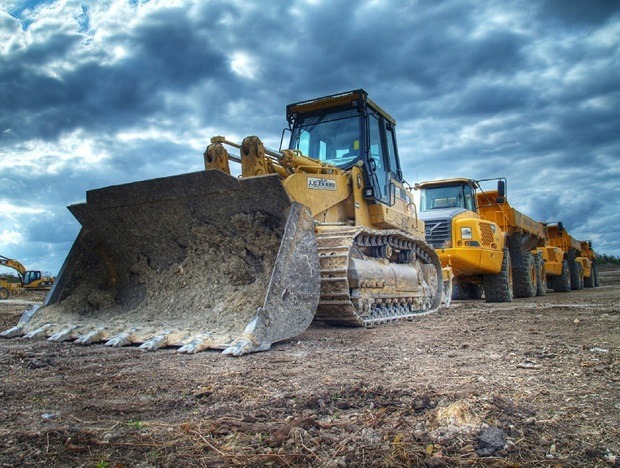Heavy construction equipment is a significant investment for any business. Construction equipment is an integral part of the construction industry and can be found in residential, commercial and industrial projects. Undercarriage parts are some of the most essential parts of a construction vehicle. They allow vehicles to move smoothly along a surface by providing traction for vehicles that lack tires or wheels, such as loaders and bulldozers.
Undercarriage Parts
Undercarriage parts are an important part of heavy machinery that help it to function properly. They provide the necessary support and stability for these machines, which can weigh in excess of 40 tons or more depending on the type.
Undercarriage parts provide support and protection to heavy construction equipment. Undercarriage parts work together to lift, push or pull weight while at the same time allowing it to move along a surface such as roads, trails, rail tracks, or even on water surfaces, depending on what type of project is being worked on.
Material Used In Making Undercarriage Parts:
Undercarriage parts are designed according to the make and model of heavy construction equipment. Undercarriage parts are manufactured in either metal or rubber, depending on machine type and use. Undercarriage parts can be made out of steel, aluminum alloy, plastic composites, fiberglass resin, or other materials. It will allow them to withstand extreme conditions while having minimal weight, which is key in keeping heavy construction equipment light and easy to transport. Undercarriage parts can also be designed for either a left-hand or right-hand side of the vehicle, depending on the machine type.
Undercarriage parts are subject to constant wear and tear, pushing them beyond their limits on a daily basis without fail.
Consequently, these undercarriage components require proper maintenance or replacement if they become worn down or damaged in any way.
Undercarriage Parts for Heavy Construction Equipment:
Undercarriage parts come in many different varieties, including track roller, top roller, sprocket, idler, track chain & shoes and track link. The most common undercarriage parts used on heavy construction equipment are tracks (track chains) and rollers (rollers).
Let’s have a look at how each of these components works.
1. Track Roller
A track roller is a spoked or solid metal wheel that supports the weight of heavy equipment to improve its speed and efficiency. Track rollers are mounted on both sides of the front guide wheels, which help support them.
The rolling action allows these machines to easily move across the country, even when passing over ditches & ruts in roads, high grass, rocks, and other debris.
Track rollers are usually made of different materials, including steel or rubber-coated metal alloy. The primary function is to support the weight of heavy construction equipment for mobility over surfaces that do not have a solid foundation like mountainsides or dirt roads with large holes in them.
2. Track Assemblies
Track assemblies are a combination of track rollers, guide wheels and sprockets that work together to support the weight of heavy construction equipment.
The front (guide) wheel is connected with a drive axle that spins on top of both sides of each roller assembly. The rear idler does not rotate but serves as an anchor point for the end link of track chain assembly to maintain a smooth and level ride.
3. Sprockets, Idlers, & Segments
Sprockets, idlers and segments are the three main components of a track assembly. A sprocket is located at the front end of a machine which links with a drive axle to spin both sides of each roller to move forward or backward.
An idler is located at the rear end of a machine which prevents track slippage and supports weight.
Segments are flat pieces that link with idlers to form a continuous loop around the rollers, also known as track shoes.
4. Track Shoes & Track Pads
Track shoes provide support for the track and help prevent slippage. Trackpads protect underlying surfaces against damage and excessive wear and tear. It also provides stability to the machine when in use on uneven ground, soft soil, etc
5. Track Links
Track links are the linked metal parts in a track assembly. Each link consists of two shoes, an inner and outer bearing (also known as bushings), rollers and lugs to secure each track shoe onto both sides of the undercarriage.
6. Track Adjusters
Track adjusters are components that maintain tension on the track assembly to keep it in place. These parts help control side-to-side movement of an undercarriage and provide stability when traveling over uneven terrain, mud, or soft ground.
7. Rollers
Rollers are large-diameter steel balls with roller bearings inside. Rollers support the weight of an undercarriage and help roll on each track shoe to move forward or backward.
8. Pins & Bushings
Pins and bushings, also known as pins and clips, are metal fasteners used to secure track shoes. Pins hold rollers on each side of an undercarriage, whereas bushing holds the link together by inserting both ends into a single hole.
9. Springs & Recoil Assemblies
Springs and recoil assemblies are suspensions that absorb shock, making them important to the comfort of a machine operator. Their role is crucial in absorbing vibration from an undercarriage as it travels along uneven ground or terrain.
Conclusion
Heavy construction equipment undercarriages parts help keep these machines running smoothly so you can work efficiently on your projects without worrying about high maintenance costs. By knowing what these parts are and how they work, you can better determine if replacement is really needed or not when an accident happens to your equipment.

